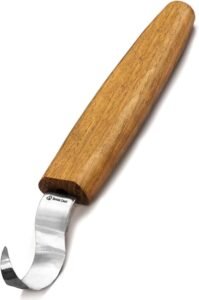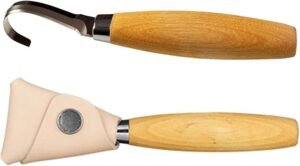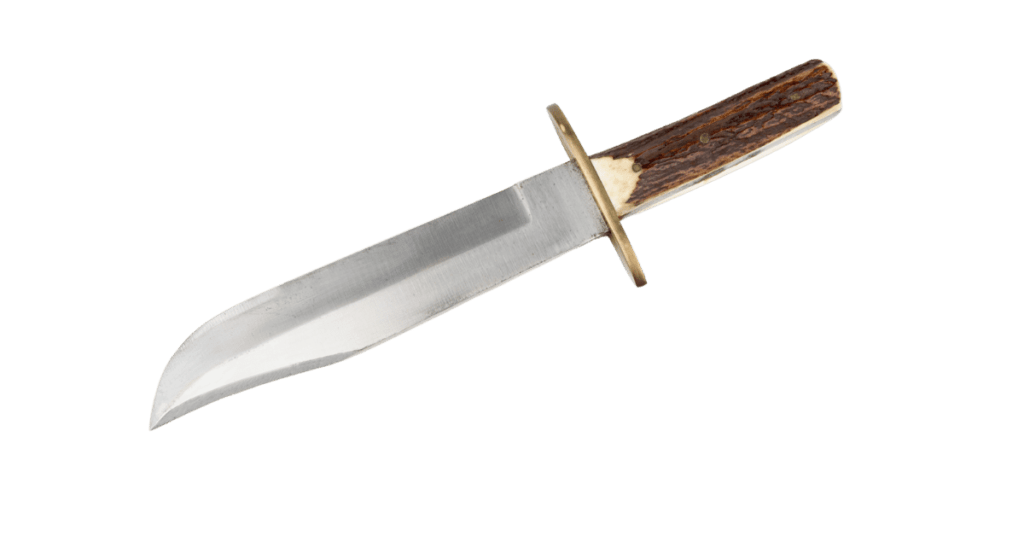A hook knife is a highly specialized tool, crucial for craftspeople who engage in wood carving, leatherworking, and other intricate handcrafts. Renowned for its curved blade, a hook knife is the go-to tool for scooping and shaping concave surfaces, such as wooden bowls, spoons, and kuksa cups. Whether you’re a beginner or an experienced carver, selecting the right hook knife can make all the difference in your project’s outcome. In this guide, we’ll cover everything you need to know about hook knives — from their various uses and types to how you can choose the best one for your needs.

What is a Hook Knife?
A hook knife is a versatile tool equipped with a curved blade that allows for controlled carving of rounded or concave shapes. Unlike straight blades, a hook knife is specifically designed to carve out material from within a hollow surface. This feature makes it indispensable for creating items like wooden spoons, bowls, and other curved objects. In leatherworking, a hook knife is similarly useful for trimming and shaping materials with precision.
Due to its design, a hook knife can remove layers of material evenly, reducing the risk of accidental cuts or gouges. The blade typically comes in various curvatures, allowing users to select the best one for their specific project.
Common Uses of a Hook Knife
Hook knives are popular among artisans across various crafts. Here are some of the most common uses:
1. Wood Carving
Wood carving is where hook knives truly shine. They’re used to hollow out areas in wood, making them perfect for crafting items like spoons, bowls, and cups. The blade’s curve allows for controlled removal of material in curved surfaces, which would be difficult to achieve with a straight blade.
2. Spoon and Bowl Carving
The most common use of a hook knife is in spoon carving and bowl making. The curved blade allows for smooth, deep cuts that help form the concave shapes of these items. The hook knife ensures that you can carve out the inside of the spoon or bowl while maintaining control over the depth and smoothness of the curve.
3. Leatherworking
In leather crafting, a hook knife is used for trimming and shaping thicker pieces of leather. Its curved blade allows artisans to make smooth, sweeping cuts on rounded surfaces. It’s particularly helpful for trimming edges where precision is essential.
4. Kuksa Cups

Hook knives are commonly used to carve kuksa cups, which are traditional wooden drinking cups from Finland. The distinct curved blade of the hook knife is specially designed to smoothly hollow out the inside of the cup, allowing the carver to carefully control the thickness and shape of the wood. This precision ensures that the cup is not only functional but also aesthetically pleasing, with uniform walls and a smooth interior finish. The hook knife is an essential tool for crafting these unique and beautiful wooden cups.
5. Pottery and Clay Work
Although less common, hook knives can be used in pottery and clay work to shape and carve intricate designs. The blade’s curve is ideal for sculpting concave sections or detailing within hollowed areas of clay.
Types of Hook Knives
There are several types of hook knives available, each with unique characteristics designed for different carving needs. Understanding the various types will help you choose the best one for your work.
1. Single-Edged Hook Knives
A single-edged hook knife is sharpened on only one side of the blade, either for right-handed or left-handed users. This type of knife allows for better control and precision, making it a great option for beginners.
Best For: Beginners and those needing precise control in wood carving.
2. Double-Edged Hook Knives
Double-edged hook knives are sharpened on both sides of the blade, allowing for cutting in either direction. While this can speed up the carving process, it requires more skill and control, which makes it more suitable for experienced carvers.
Best For: Advanced users looking for faster, symmetrical cutting.
3. Short-Blade Hook Knives
A short-blade hook knife offers more control over finer details. The short blade is perfect for intricate carvings where precision is more important than the speed of material removal.
Best For: Fine detailing, precision carving, intricate work.
4. Long-Blade Hook Knives
Long-blade hook knives are designed to remove large amounts of material quickly. These knives are typically used in the early stages of a project when you’re shaping the basic form of your object.
Best For: Rough carving, initial shaping, large projects.
5. Right-Handed and Left-Handed Hook Knives
Single-edged hook knives can be tailored to either right- or left-handed users. Choosing the correct hand orientation ensures better control and ergonomics during your work.
Best For: Users looking for comfort and control based on their dominant hand.
How to Choose the Right Hook Knife
Choosing the right hook knife for your work depends on several factors, including the type of project you plan to undertake and your skill level. Here are key considerations to guide you in selecting the perfect hook knife:
1. Blade Material
The quality of the blade material is crucial to the knife’s performance. Most high-quality hook knives are made from high-carbon steel, which provides excellent durability and sharpness. Stainless steel is another popular choice as it is resistant to rust, though it may require more frequent sharpening.
Recommendation: Opt for a high-carbon steel blade for a balance of sharpness, strength, and longevity.
2. Blade Curvature
The blade curvature affects how well the knife performs in different carving tasks. Tighter curves are ideal for small, detailed work like spoon carving, while wider curves are better for larger, sweeping cuts, such as those needed in bowl or kuksa cup carving.
- Tight Curve: Best for detailed projects like spoon carving.
- Wide Curve: Ideal for larger projects like bowl carving.
3. Handle Design and Comfort
Since carving often involves extended periods of time working with your hands, choosing a hook knife with an ergonomic handle is essential. Wooden handles are popular for their comfort, durability, and natural feel, though synthetic options can offer additional grip.
Recommendation: Choose a handle that feels comfortable and offers a secure grip for better control and reduced hand fatigue.
4. Blade Length
Shorter blades provide more control and are ideal for detailed work, while longer blades are better for removing large amounts of material quickly.
Recommendation: Beginners may want to start with a shorter blade for precision, while more experienced users can choose longer blades for faster material removal.
5. Single or Double-Edged
For beginners, single-edged hook knives offer more control and are easier to handle. Double-edged knives, on the other hand, allow for faster cutting but require more skill to use effectively.
Recommendation: Beginners should opt for single-edged knives, while experienced carvers may prefer double-edged blades for their speed and versatility.
How to Maintain Your Hook Knife
Maintaining your hook knife is essential to keep it performing at its best. Here are the basic steps for caring for your hook knife:
1. Sharpen Regularly
To keep your hook knife effective, regularly sharpen it using a fine-grit sharpening stone or honing tool. A sharp knife not only makes carving easier but also ensures cleaner, more precise cuts.
2. Strop the Blade
After sharpening, strop the blade on a leather strop to remove any burrs and further refine the edge. Stropping also helps maintain a razor-sharp edge for longer periods.
3. Oil the Blade
Especially if your knife is made from high-carbon steel, it’s important to oil the blade to prevent rust. Use a light coat of mineral oil or another protective oil after each use.
4. Store Safely
Always store your hook knife in a dry, secure location. Consider using a protective sheath to cover the blade and prevent accidental damage or injuries.
Recommended Hook Knives for Different Skill Levels
Finding the right hook knife can be overwhelming with the many options available. Here are a few top-rated knives for different skill levels:
Best Hook Knife for Beginners: BeaverCraft SK1 Spoon Carving Hook Knife

The BeaverCraft SK1 is a top choice for beginners who are just starting their wood carving journey. Its blade is made from high-carbon steel, a material known for its toughness and ability to maintain a sharp edge. This means the knife will stay sharp for longer periods, requiring less frequent sharpening. The single-edged blade design provides excellent control, allowing beginners to make more precise and accurate cuts. It is especially useful for carving spoons, as it smoothly shapes the concave areas with ease. The handle is crafted from durable hardwood and shaped ergonomically to fit comfortably in your hand. This reduces hand fatigue during longer carving sessions, making it easier for beginners to work for extended periods. Overall, the BeaverCraft SK1 offers durability, comfort, and control—everything a beginner needs to get started on projects like spoon carving or simple bowls.
Best Hook Knife for Intermediate Carvers: Morakniv 164 Hook Knife

The Morakniv 164 is designed for intermediate woodcarvers looking to improve their skills. Unlike the BeaverCraft SK1, this knife features a double-edged blade, which allows for faster and more versatile carving techniques. The blade is crafted from Swedish stainless steel, a material known for its resistance to rust and corrosion, ensuring that the knife will last through years of use with minimal maintenance. The sharpness of the blade allows for clean and precise cuts, making it ideal for more advanced projects like carving bowls or kuksa cups. The handle is simple but effective, providing a solid grip, which is important when working on more intricate details. The Morakniv 164 balances speed and precision, making it the perfect tool for intermediate carvers ready to tackle more complex designs.
Best Hook Knife for Professionals: Flexcut KN52 Hook Knife

For professional carvers who demand precision and performance, the Flexcut KN52 stands out as the best option. The knife features a single-edged high-carbon steel blade, which is known for its extreme sharpness and ability to hold a fine edge for a long time. This makes it perfect for intricate and detailed carving work. The larger handle is designed for maximum comfort and control, allowing professionals to work on detailed projects for long periods without straining their hands. This knife excels at precision carving, offering the sharpness and control needed to create fine details in spoons, bowls, or other woodcraft items. Its high-quality materials and superior craftsmanship make the Flexcut KN52 the go-to choice for professionals looking to elevate their carving projects to the next level.
Final Thoughts on Choosing the Right Hook Knife
A hook knife is an invaluable tool for artisans engaged in wood carving, leatherworking, and other creative projects. Selecting the right knife requires considering factors such as the blade material, curvature, handle comfort, and length. Whether you’re a beginner or a seasoned professional, this guide has provided the essential knowledge you need to make an informed decision.
By investing in a quality hook knife suited to your specific needs, you’ll not only improve your craftsmanship but also enjoy a smoother, more efficient carving process. Start by identifying your project goals, and use the insights in this guide to find the perfect hook knife for your craft.

